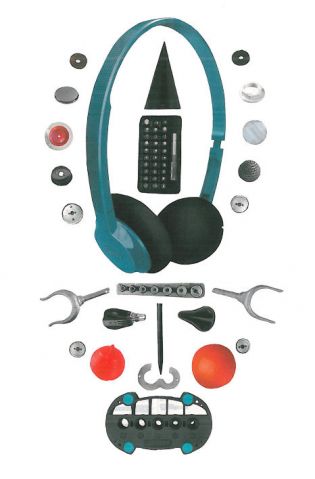Week 16: 31st December – 6th January
Ever since my recent visit to the Wellcome Collection, and subsequent investigation of anatomical imagery, I’ve been interested in the mask-like quality of my work. I first started making masks as an addition to my textile sculpture, but it was as a result of a collaboration with photographer, Zeev Parush, back in 2009, that I really started thinking about the performative qualities of the objects.
Mask making
I’ve recently been playing around with the idea of making paper masks, as a link to artist books, but have been struggling with developing imagery to match the concepts. I decided to go back to the drawing board by reading ‘African masks from the Barbier-Mueller Collection, Geneva.’
The book, containing a preface, essay, and a collection of plates, began by reflecting on previous artists recognition and appropriation of African art, the most notable of which were ‘Andre Derain, Maurice de Vlaminck, Pablo Picasso, Georges Braque, and the Cubists, followed by the Expressionists and Surrealists, who recognised the aesthetic qualities of the sacred sculptures and masks.’ (p7)
Of course, this is not to say that these artists were the ones to discover these aesthetic qualities, but rather that they were the first to categorise these objects as art within the Western model, as opposed to previous collections, which had defined the objects according to their ethnographic significance. As Cristoph Vitali writes ‘They were fascinated by the formal dynamism and expressive power of African objects, which corresponded to their own search for simplified forms and directness and immediacy of expression.’ (p7)
Classification
Using physical characteristics only, the book identifies 6 types of mask, in order to try to understand and classify aesthetic systems of African objects. These types include face masks, helmet masks, helmet crests, cap crests or forehead masks, headdress masks, and shoulder masks. (p15)
Each mask is a variant of one of these basic types, depending on region, culture or purpose: ‘The contour of a mask, the proportions of the features, the use of convex or concave surfaces, the shape of the eyes and eyebrows, nose and nostrils, mouth and corners of the mouth, of ears, teeth, hairdo, scarification patterns, and finally painting – all are useful aids to stylistic classification.’ (p20)
The function of an art object
However, my search is not purely aesthetic, as it also relates to the function of the object and the social relationships that it mediates. This is especially important in a museum context as ‘many masks now in museums and private collections have been, as it were, mutilated, only the appealing face or head portion having been saved. Missing are the costume made of raffia, textiles, animal hides or pelts, feathers or leaves, as well as the masker’s paraphernalia… despite the fact that all of these often play a salient role in mask dances.’ (p14)
This also echoes my interest in relational art, which stems from a desire to create artwork that is more immersive and allows for creative interpretation by audience members, as opposed to passive consumption. In this way, research into the social context of African art, opens up new possibilities for participation within my own practice.
Commodity masks
Back to resolving the original imagery issue, I decided to use the information at hand to create a spreadsheet of characteristics including each of the basic forms and variations, specific features, materials, markings, functions, spiritual meanings and associated rituals. I’ve also been creating a few collages from magazine cut-outs, so I thought that process would make a relatively quick solution for working out mask forms and related imagery. I began by selecting objects from a catalogue and arranging them so that they resembled faces.
Although this work is still quite far away from my proposed outcomes, nevertheless I’m enjoying these preliminary stages, and looking forward to the associations people might between the forms and objects, as well as how the work will develop in the future.

